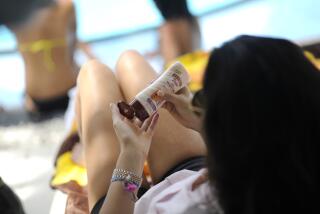The UV-A Dilemma - New Sunscreens Filter Harmful UV-A Rays, But the Question Is, How Much?
NOT TOO LONG ago, protecting one’s skin from the damaging sun was simple: A beach-bound consumer could pick a sunscreen labeled SPF 15, slather it on and feel adequately shielded from ultraviolet (UV) radiation. But today, sunscreen labels have become complex and often misleading.
The savvy sunscreen shopper knows that SPF numbers refer only to protection against UV-B rays and in no way indicate protection against UV-A rays. Although UV-B rays have long been known to cause sunburn and skin cancer, UV-A rays have been found only recently to contribute to sunburn, skin cancer, the aging of the skin and potential problems with the effectiveness of the immune system. (Once thought to be harmless, UV-A radiation is the form most often used in tanning parlors.)
Dr. Nicholas J. Lowe, a UCLA clinical professor of dermatology and director of the Santa Monica-based Skin Research Foundation of California, says that guarding against UV-A rays is essential, especially in Southern California, where the temperate climate draws people outdoors. He explains that UV-A rays comprise a greater proportion of sunlight than UV-B rays do, are present year-round, penetrate the skin more deeply than UV-B rays and, most important, can cause damage even through windows of buildings and cars.
“Patients come to me wondering why they are having sun-related problems when they’re using an SPF-labeled sunscreen or when they’re staying indoors,” he says. “It’s because they’re driving their car to the supermarket and to work, because they sit in their office near a window and because they’re easily getting enough UV-A coming through those windows to activate problems.” Lowe recommends daily use of a sunscreen that filters both UV-B and UV-A rays.
Many sunscreen manufacturers have changed their formulas to include UV-A sunscreens. In the industry, these products have become known as “broad-spectrum sunscreen preparations,” and their labeling and advertising tout “broad-spectrum protection.” According to the U.S. Food and Drug Administration, however, there is currently no acceptable testing procedure to determine how much UV-A protection a product provides. Consequently, labels that quantify UV-A protection are, in the words of William Gilbertson, director of over-the-counter drug evaluation for the FDA, “unsubstantiated and therefore unacceptable, and any such product may be subject to regulatory action.”
Gilbertson’s statement came in response to a labeling system proposed by Schering-Plough Corp., maker of Coppertone and Shade Sunblock products. The Schering-Plough label, which would have indicated the percentage of UV-A rays blocked, was rejected.
So far, the FDA has approved only one product as a UV-A sunscreen: Photoplex. Manufactured by Allergan’s Herbert Laboratories in Santa Ana, it contains Parsol 1789, a UV-A-absorbing ingredient. Parsol 1789 was not on the FDA-approved list of sunscreen ingredients, so the FDA required Herbert Laboratories to provide clinical test results of both its safety and effectiveness. Based on three years of tests, which were specific to the Parsol 1789 formula and thus not applicable to other products, the FDA approved Photoplex as a UV-B and UV-A screen. Since then, it has become the yardstick, and all other sunscreens are trying to measure up.
At Estee Lauder, Walter Smith, senior vice president of research and development, says that his company used Photoplex protection figures as the benchmarks for its own sunscreen products. According to Smith, both Photoplex and Estee Lauder Sun SPF 30, which is made of FDA-approved sunscreen ingredients, absorb about 99% of UV-B rays, 70% of UV-A rays and 50% of infrared rays.
Why not 100% in all spectrums? “Until three years ago, the FDA and the scientific community barely recognized the importance of UV-A protection,” he says. “Right now, ingredients that would provide total blockage are not very aesthetically pleasing” because of their texture and smell. The technology to make such components acceptable is at least five years off. Perhaps by then the FDA will have found an acceptable testing process and a comprehensive labeling system.
Stylist: Julie Vogel/Cloutier; hair and makeup: Lori-Jean Swanson; model: Arcelia Negrete/Carol Crawford






